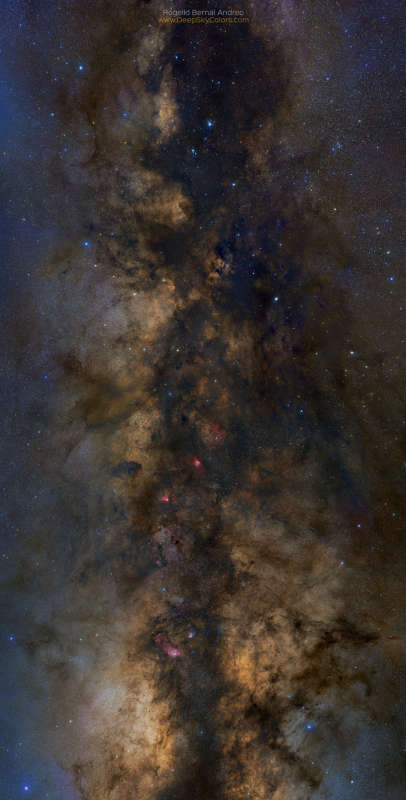
|
Credit & Copyright: Rogelio Bernal
Andreo (Deep Sky Colors)
Explanation:
Over 100 telescopic image
panels in this stunning vertical mosaic span
about 50 degrees
across
the night sky.
They follow part of the
Great Rift, the
dark river
of dust and molecular gas that stretches
along the plane of our Milky Way Galaxy.
Start at top center and you can follow the
galactic
equator down through brighter stars in constellations Aquila,
Serpens Cauda, and Scutum.
At the bottom is Sagittarius near the center of the Milky Way.
Along the way you'll encounter many obscuring
dark
nebulae hundreds of light-years distant flanked by bands of
Milky Way starlight, and the telltale reddish glow of starforming regions.
Notable Messier objects
include The Eagle (M16) and Omega (M17)
nebulae, the Sagittarius Star Cloud (M24), the beautiful Trifid (M20)
and the deep Lagoon (M8).
|
January February March April May June July August September October November December |
| ||||||||||||||||||||||||||||||||||||||||||||||||
NASA Web Site Statements, Warnings, and Disclaimers
NASA Official: Jay Norris. Specific rights apply.
A service of: LHEA at NASA / GSFC
& Michigan Tech. U.
Based on Astronomy Picture
Of the Day
Publications with keywords: Milky Way
Publications with words: Milky Way
See also:
- APOD: 2025 July 2 Á Milky Way Through Otago Spires
- APOD: 2025 May 20 Á Milky Way over Maunakea
- APOD: 2025 May 13 Á Gaia Reconstructs a Top View of our Galaxy
- APOD: 2025 May 12 Á Gaia Reconstructs a Side View of our Galaxy
- Galaxies in Space
- APOD: 2025 February 9 Á Milky Way over the Australian Pinnacles
- APOD: 2024 November 24 Á Journey to the Center of the Galaxy
